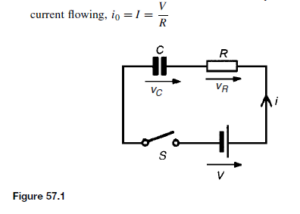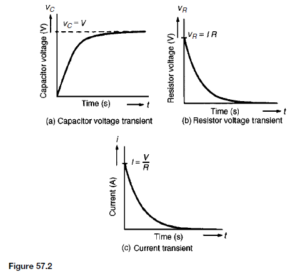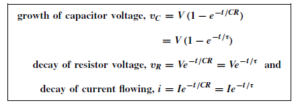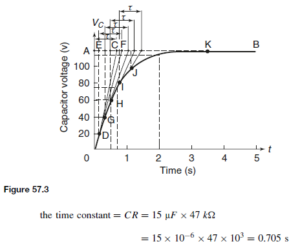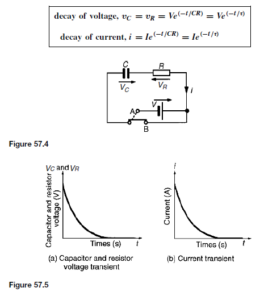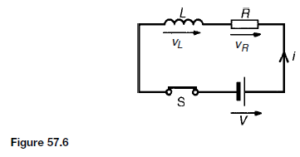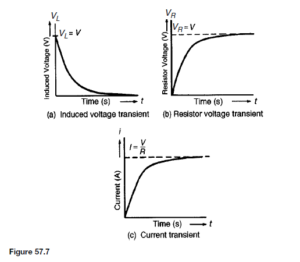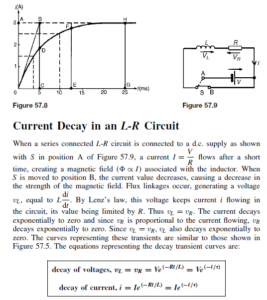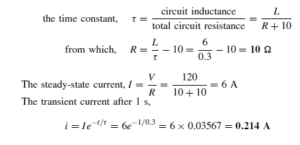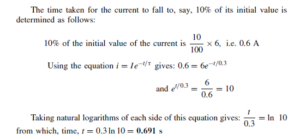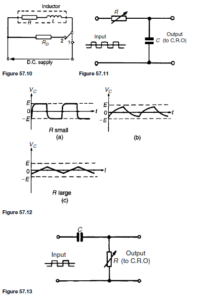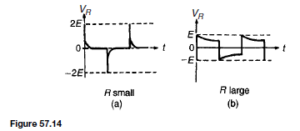Introduction
When a d.c. voltage is applied to a capacitor C and resistor R connected in series, there is a short period of time immediately after the voltage is connected, during which the current flowing in the circuit and voltages across C and R are changing.
Similarly, when a d.c. voltage is connected to a circuit having inductance L connected in series with resistance R, there is a short period of time immediately after the voltage is connected, during which the current flowing in the circuit and the voltages across L and R are changing.
These changing values are called transients.
Charging a Capacitor
(a) The circuit diagram for a series connected C-R circuit is shown in Figure 57.1 When switch S is closed then by Kirchhoff’s voltage law:
The battery voltage V is constant. The capacitor voltage vC is given by q/c, where q is the charge on the capacitor. The voltage drop across R is given by iR, where i is the current flowing in the circuit. Hence at all times:
At the instant of closing S, (initial circuit condition), assuming there is no initial charge on the capacitor, q0 is zero, hence vCo is zero. Thus from equation (1), V D 0 C vRo , i.e. vRo D V
This shows that the resistance to current is solely due to R, and the initial
(c) A short time later at time t1 seconds after closing S, the capacitor is partly charged to, say, q1 coulombs because current has been flowing. The voltage vC1 is now C volts. If the current flowing is i1 amperes, then the voltage drop across R has fallen to i1 R volts. Thus, equation (2) is now V q1 i R
(d) A short time later still, say at time t2 seconds after closing the switch, the charge has increased to q2 coulombs and vC has increased to volts.
Since V D vC C vR and V is a constant, then vR decreases to i2 R, Thus vC is increasing and i and vR are decreasing as time increases.
(e) Ultimately, a few seconds after closing S, (i.e. at the final or steady state condition), the capacitor is fully charged to, say, Q coulombs, current no longer flows, i.e. i D 0, and hence vR D iR D 0. It follows from equation (1) that vC D V
(f) Curves showing the changes in vC, vR and i with time are shown in Figure 57.2 The curve showing the variation of vC with time is called an exponential growth curve and the graph is called the ‘capacitor voltage/time’ characteristic. The curves showing the variation of vR and i with time are called exponential decay curves, and the graphs are called ‘resistor voltage/time’ and ‘current/time’ characteristics respectively. (The name ‘exponential’ shows that the shape can be expressed mathematically by an exponential mathematical equation, as shown later)
Time Constant for a C -R Circuit
Time constant is defined as:
the time taken for a transient to reach its final state if the initial rate of change is maintained
For a series connected C-R circuit,
Transient Curves for a C -R Circuit
There are two main methods of drawing transient curves graphically, these being:
(a) the tangent method — this method is shown in an example below
(b) the initial slope and three point method, which is based on the following properties of a transient exponential curve:
(i) for a growth curve, the value of a transient at a time equal to one time constant is 0.632 of its steady state value (usually taken as 63% of the steady state value), at a time equal to two and a half time constants is 0.918 of its steady state value (usually taken as 92% of its steady state value) and at a time equal to five time constants is equal to its steady state value,
(ii) for a decay curve, the value of a transient at a time equal to one time
constant is 0.368 of its initial value (usually taken as 37% of its initial value), at a time equal to two and a half time constants is 0.082 of its initial value (usually taken as 8% of its initial value) and at a time equal to five time constants is equal to zero.
The transient curves shown in Figure 57.2 have mathematical equations, obtained by solving the differential equations representing the circuit. The equations of the curves are:
For example, a 15 µF uncharged capacitor is connected in series with a 47 kQ resistor across a 120 V, d.c. supply. Thus,
Steady state value of vC = V, i.e. vC = 120 V
With reference to Figure 57.3, the scale of the horizontal axis is drawn so that it spans at least five time constants, i.e. 5 ð 0.705 or about 3.5 seconds. The scale of the vertical axis spans the change in the capacitor voltage, that is, from 0 to 120 V. A broken line AB is drawn corresponding to the final value of vC Point C is measured along AB so that AC is equal to 1r, i.e. AC D 0.705 s.
Straight line OC is drawn. Assuming that about five intermediate points are needed to draw the curve accurately, a point D is selected on OC corresponding to a vC value of about 20 V. DE is drawn vertically. EF is made to correspond to 1r, i.e. EF D 0.705 s. A straight line is drawn joining DF. This procedure of (a) drawing a vertical line through point selected,
(b) at the steady-state value, drawing a horizontal line corresponding to 1r, and
(c) joining the first and last points, is repeated for vC values of 40, 60, 80 and 100 V, giving points G, H, I and J
The capacitor voltage effectively reaches its steady-state value of 120 V after a time equal to five time constants, shown as point K. Drawing a smooth curve through points O, D, G, H, I, J and K gives the exponential growth curve of capacitor voltage.
From the graph, the value of capacitor voltage at a time equal to the time constant is about 75 V. It is a characteristic of all exponential growth curves, that after a time equal to one time constant, the value of the transient is
0.632 of its steady-state value. In this example, 0.632 x 120 = 75.84 V. Also from the graph, when t is two seconds, vC is about 115 Volts. This value may be checked using the equation vC = V(1 – e-t/r ), where V = 120 V, r = 0.705 s and t = 2 s. This calculation gives vC D 112.97 V.
The time for vC to rise to one half of its final value, i.e. 60 V, can be determined from the graph and is about 0.5 s. This value may be checked using vC D V(1 – e-t/r ) where V D 120 V, vC D 60 V and r D 0.705 s, giving t D 0.489 s.
Discharging a Capacitor
When a capacitor is charged (i.e. with the switch in position A in Figure 57.4), and the switch is then moved to position B, the electrons stored in the capacitor keep the current flowing for a short time. Initially, at the instant of moving from A to B, the current flow is such that the capacitor voltage vC is balanced by an equal and opposite voltage vR = iR. Since initially vC = vR = V, then i = I = V/R. During the transient decay, by applying Kirchhoff’s voltage law to Figure 52.4, vC = vR. Finally the transients decay exponentially to zero, i.e. vC D vR D 0. The transient curves representing the voltages and current are as shown in Figure 57.5.
The equations representing the transient curves during the discharge period of a series connected C-R circuit are:
For example, a capacitor is charged to 100 V and then discharged through a 50 kQ resistor. If the time constant of the circuit is 0.8 s, then, since time constant, r D CR, capacitance,
When a capacitor has been disconnected from the supply it may still be charged and it may retain this charge for some considerable time. Thus pre- cautions must be taken to ensure that the capacitor is automatically discharged after the supply is switched off. Connecting a high value resistor across the capacitor terminals does this.
In a d.c. circuit, a capacitor blocks the current except during the times that there are changes in the supply voltage.
Current growth in an L-R circuit
(a) The circuit diagram for a series connected L-R circuit is shown in Figure 57.6. When switch S is closed, then by Kirchhoff’s voltage law:
(b) The battery voltage V is constant. The voltage across the inductance is the induced voltage, i.e.
(c) At the instant of closing the switch, the rate of change of current is such that it induces an e.m.f. in the inductance which is equal and opposite
to V, hence V = vL C 0, i.e. vL = V. From equation (3), because vL = V, then vR= 0 and i = 0
(d) A short time later at time t1 seconds after closing S, current i1 is flowing, since there is a rate of change of current initially, resulting in a voltage drop of i1 R across the resistor. Since V (which is constant) = vL C vR the induced e.m.f. is reduced, and equation (4) becomes:
(e) A short time later still, say at time t2 seconds after closing the switch, the current flowing is i2 , and the voltage drop across the resistor increases to i2 R. Since vR increases, vL decreases.
(f) Ultimately, a few seconds after closing S, the current flow is entirely limited by R, the rate of change of current is zero and hence vL is zero. Thus V D iR. Under these conditions, steady state current flows, usually signified by I. Thus, I D R , vR D IR and vL D 0 at steady state conditions.
(g) Curves showing the changes in vL , vR and i with time are shown in Figure 57.7 and indicate that vL is a maximum value initially (i.e. equal to V), decaying exponentially to zero, whereas vR and i grow exponentially from zero to their steady state values of and I =V/ R respectively.
Time Constant for an L-R Circuit
The time constant of a series connected L-R circuit is defined in the same way as the time constant for a series connected C-R circuit. Its value is given by:
Transient Curves for an L-R Circuit
Transient curves representing the induced voltage/time, resistor voltage/time and current/time characteristics may be drawn graphically, as outlined earlier. Each of the transient curves shown in Figure 57.7 have mathematical equations, and these are:
For example, a relay has an inductance of 100 mH and a resistance of 20 Q. It is connected to a 60 V, d.c. supply.
(a) The scales should span at least five time constants (horizontally), i.e. 25 ms, and 3 A (vertically).
(b) With reference to Figure 57.8, the initial slope is obtained by making AB equal to 1 time constant, (i.e. 5 ms), and joining OB.
(c) At a time of 1 time constant, CD is 0.632 x I D 0.632 x 3 = 1.896 A. At a time of 2.5 time constants, EF is 0.918 x I = 0.918 x 3 D 2.754 A. At a time of 5 time constants, GH is I = 3 A.
(d) A smooth curve is drawn through points 0, D, F and H and this curve is the current/time characteristic.
For example, a coil having an inductance of 6 H and a resistance of R Q is connected in series with a resistor of 10 Q to a 120 V, d.c. supply. The time constant of the circuit is 300 ms. When steady-state conditions have been reached, the supply is replaced instantaneously by a short-circuit. Thus,
Switching Inductive Circuits
Energy stored in the magnetic field of an inductor exists because a current provides the magnetic field. When the d.c. supply is switched off the current falls rapidly, the magnetic field collapses causing a large induced e.m.f. which will either cause an arc across the switch contacts or will break down the insulation between adjacent turns of the coil. The high induced e.m.f. acts in a direction which tends to keep the current flowing, i.e. in the same direction as the applied voltage. The energy from the magnetic field will thus be aided by the supply voltage in maintaining an arc, which could cause severe damage to the switch. To reduce the induced e.m.f. when the supply switch is opened, a discharge resistor RD is connected in parallel with the inductor as shown in Figure 57.10. The magnetic field energy is dissipated as heat in RD and R and arcing at the switch contacts is avoided.
The Effects of Time Constant on a Rectangular Waveform
Integrator circuit
By varying the value of either C or R in a series connected C-R circuit, the time constant (r D CR), of a circuit can be varied. If a rectangular waveform varying from CE to -E is applied to a C-R circuit as shown in Figure 57.11, output waveforms of the capacitor voltage have various shapes, depending on the value of R.
When R is small, r D CR is small and an output waveform such as that shown in Figure 57.12(a) is obtained. As the value of R is increased, the waveform changes to that shown in Figure 57.12(b). When R is large, the waveform is as shown in Figure 57.12(c), the circuit then being described as an integrator circuit.
Differentiator circuit
If a rectangular waveform varying from CE to -E is applied to a series connected C-R circuit and the waveform of the voltage drop across the resistor is observed, as shown in Figure 57.13, the output waveform alters as R is varied due to the time constant, (r D CR), altering.
When R is small, the waveform is as shown in Figure 57.14(a), the voltage being generated across R by the capacitor discharging fairly quickly. Since the change in capacitor voltage is from CE to -E, the change in discharge current is 2E/R, resulting in a change in voltage across the resistor of 2E. This circuit is called a differentiator circuit. When R is large, the waveform is as shown in Figure 57.14(b).

